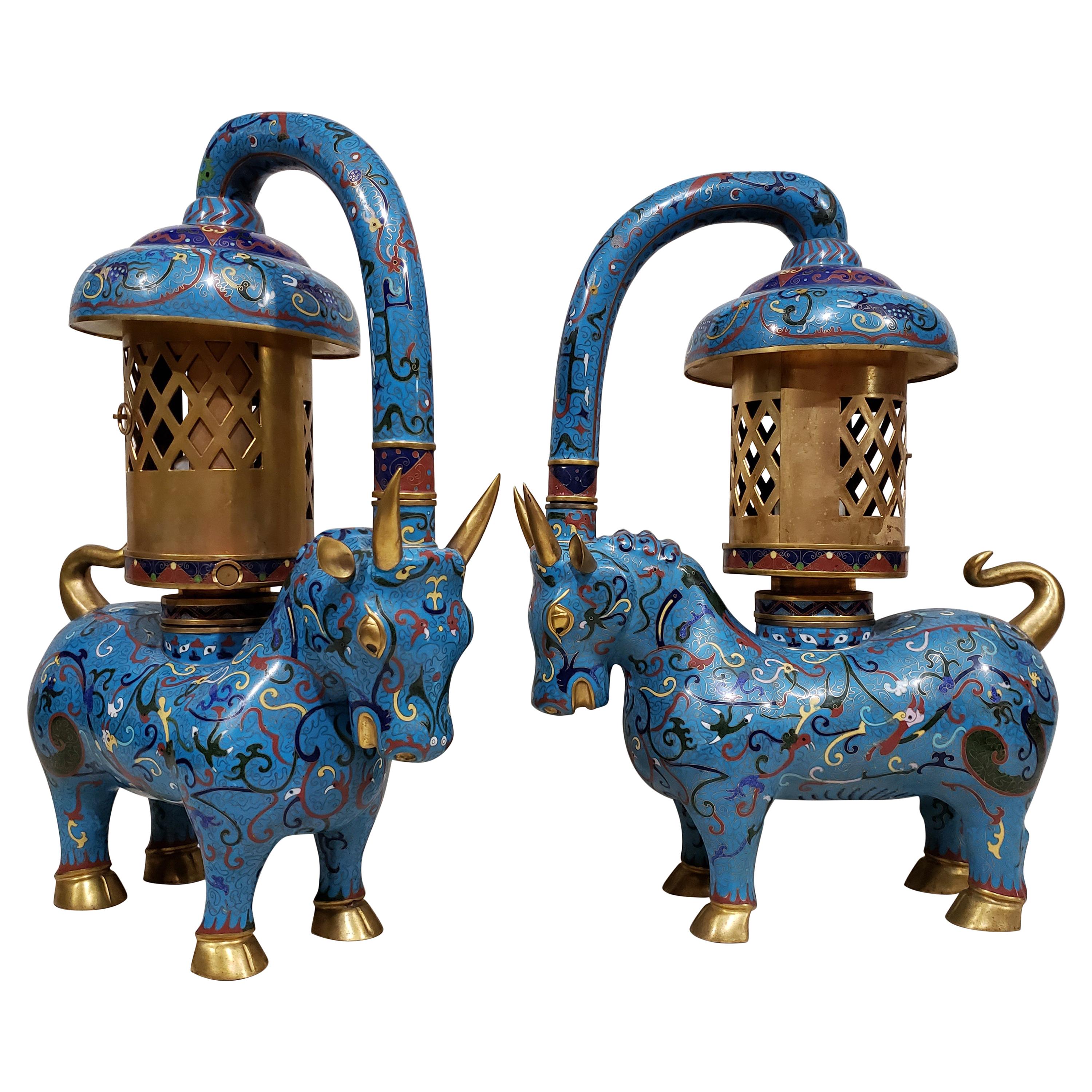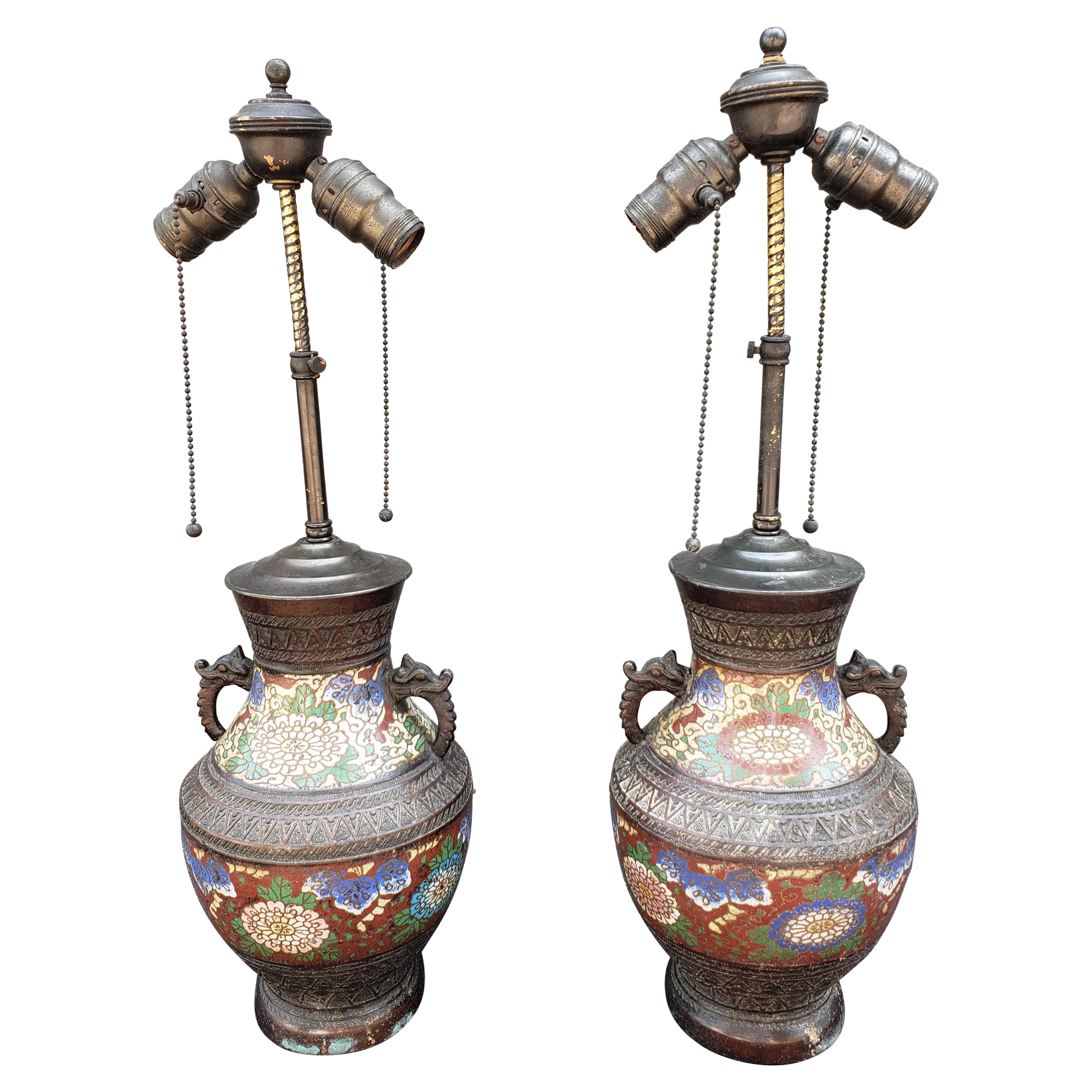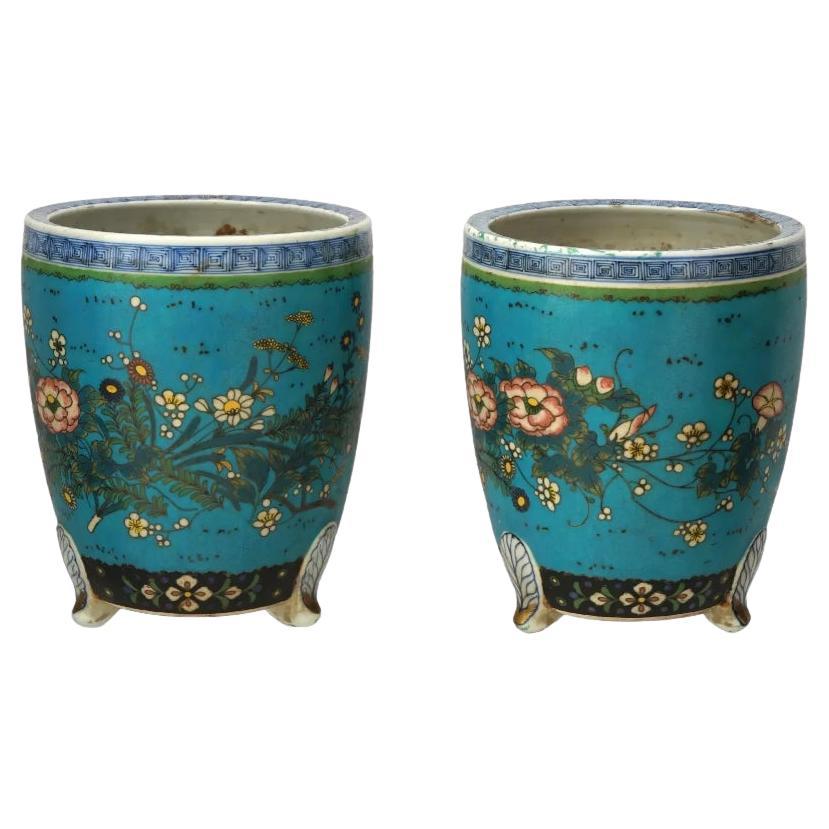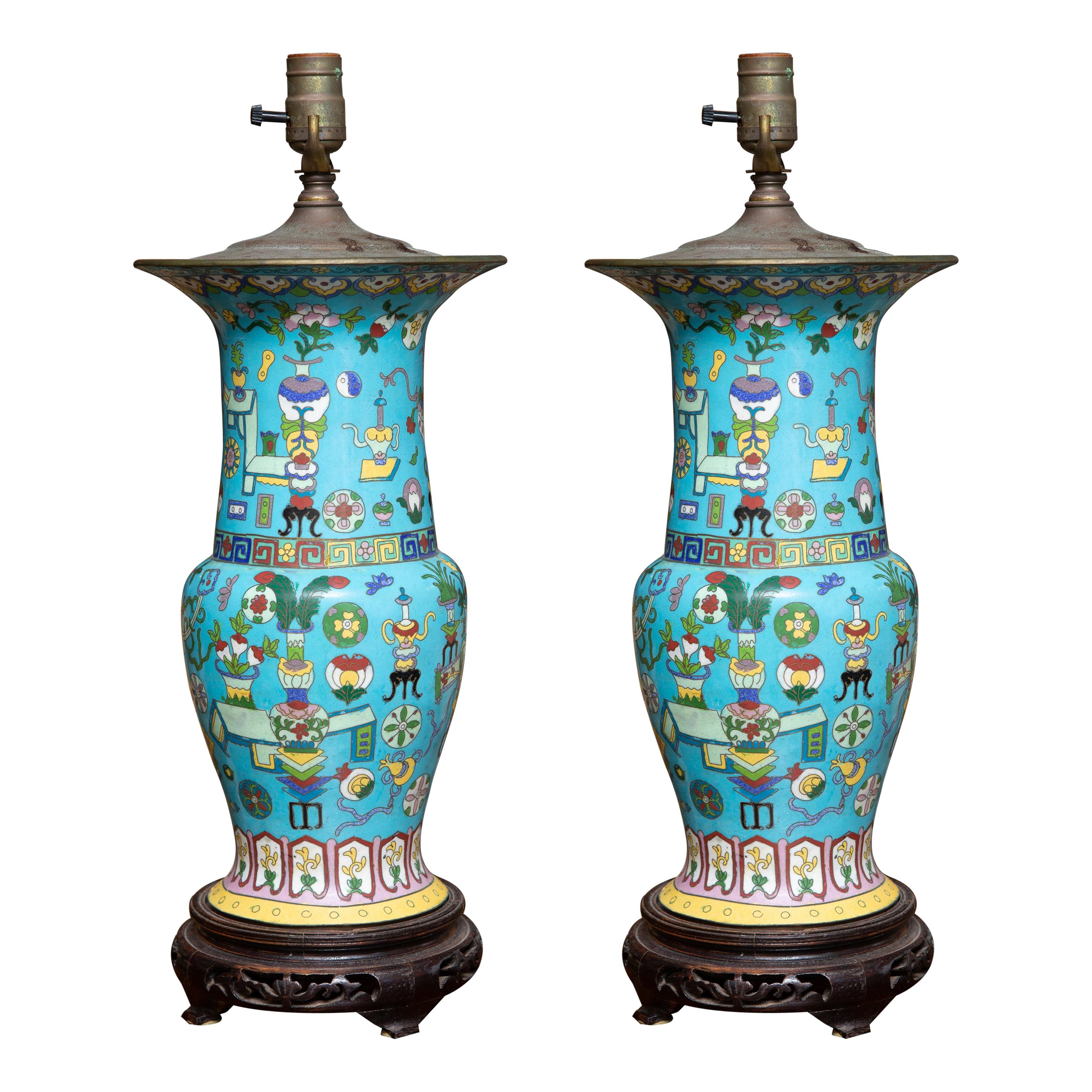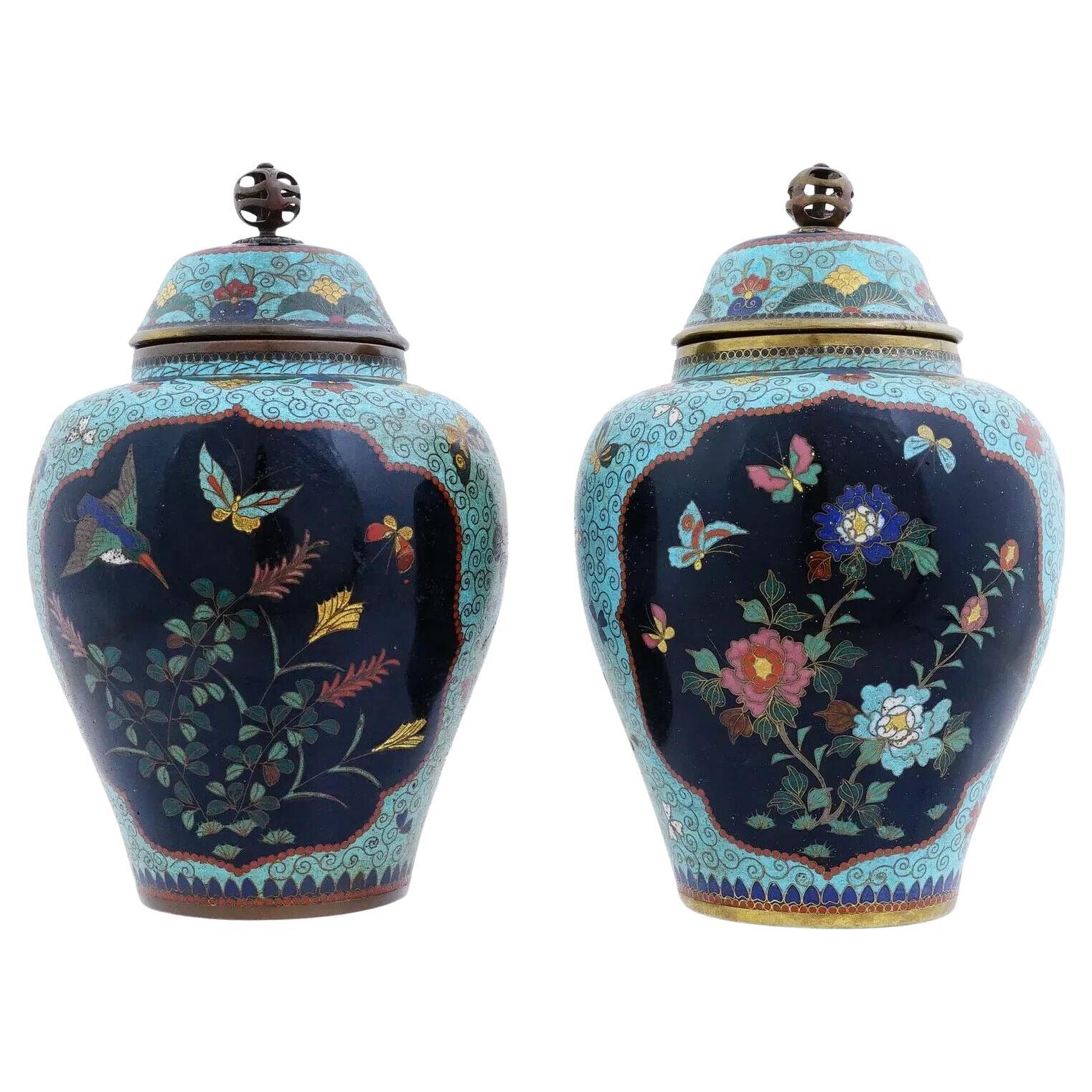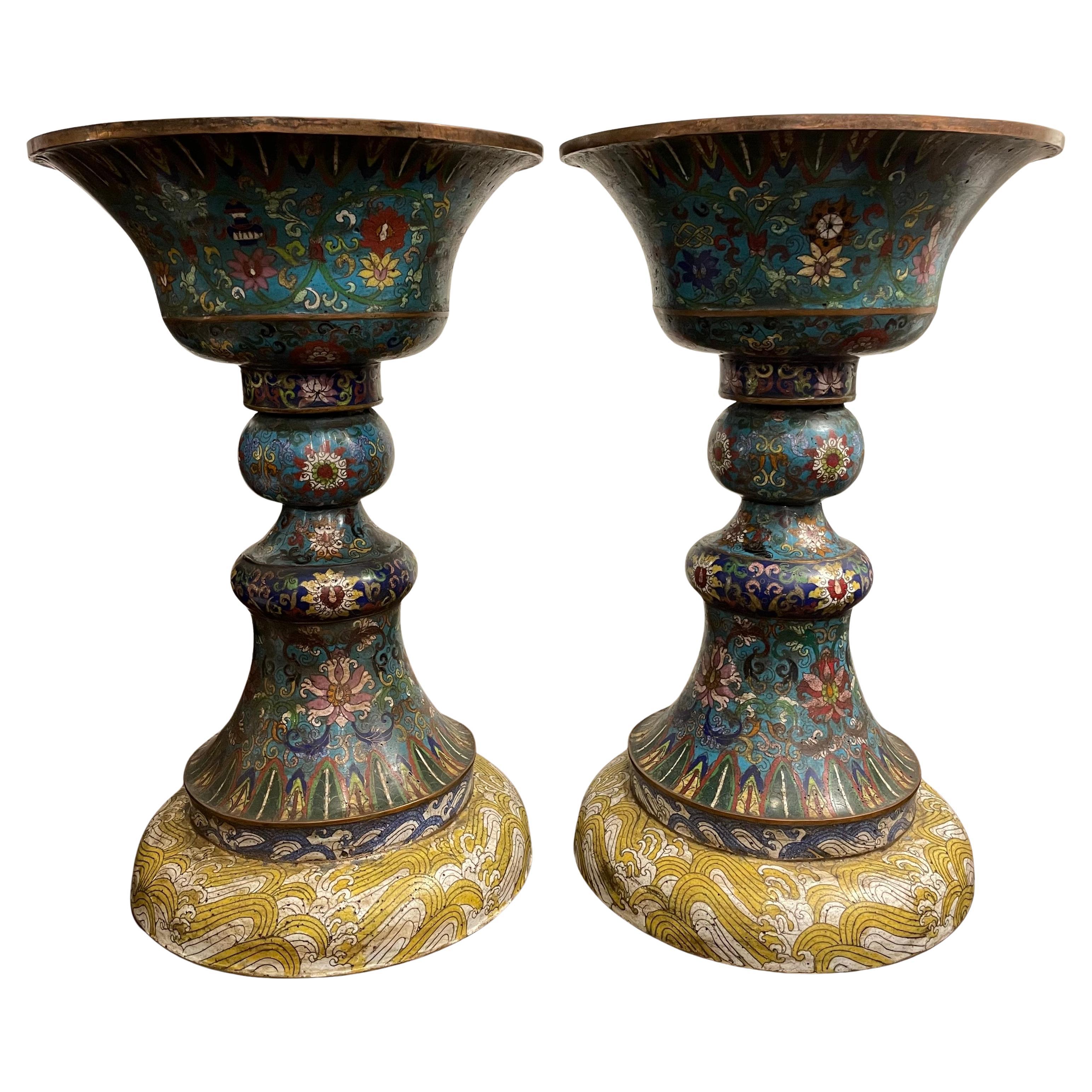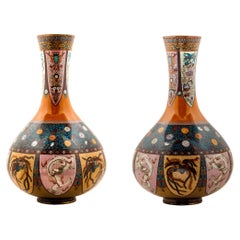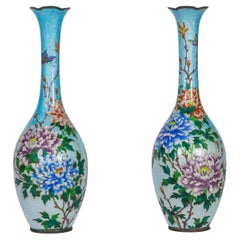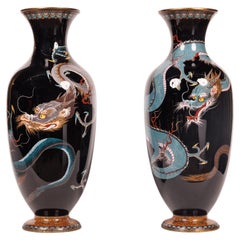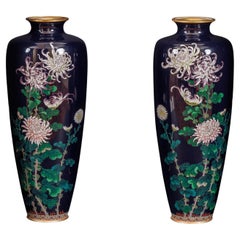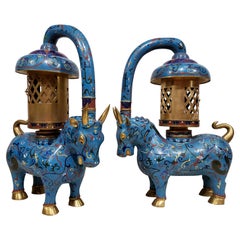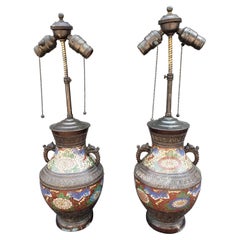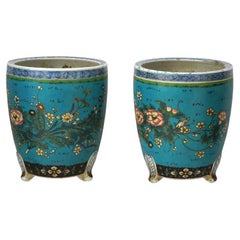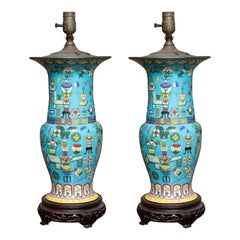Items Similar to Large Pair of Japanese Cloisonne Enamel Lanterns Attributed to Kaji Tsunekichi
Video Loading
Want more images or videos?
Request additional images or videos from the seller
1 of 17
Large Pair of Japanese Cloisonne Enamel Lanterns Attributed to Kaji Tsunekichi
$45,000
£34,149.14
€39,103.59
CA$63,948.11
A$69,599.78
CHF 36,539.25
MX$840,866.89
NOK 458,608.01
SEK 432,413.11
DKK 291,904.77
About the Item
A Large Pair of Japanese Cloisonne Enamel Lanterns Attributed to Kaji Tsunekichi, Edo Period, 19th century
Japanese cloisonne lanterns were made during the Meiji period, from the late 19th to early 20th century, and were often used as decorative lighting fixtures in temples and shrines.
Kaji Tsunekichi (1866-1916) was a Japanese cloisonné artist who was active in the late 19th and early 20th centuries. He was born in Tokyo and learned the art of cloisonné from his father, Kaji Sataro, who was also a cloisonné artist. He was renowned for his mastery of the shippo-yaki technique, which involves creating intricate designs with thin wires on a metal base before filling in the spaces with enamel.
Tsunekichi was known for his exceptional technical skills and his ability to create intricate designs with vibrant colors. His works often featured nature motifs, such as flowers, birds, and fish, which were rendered in a highly detailed and naturalistic style. He also experimented with new techniques, such as plique-à-jour, a type of cloisonné that creates a stained-glass effect.
Tsunekichi's works were highly prized during his lifetime and continue to be sought after by collectors today. He won numerous awards for his cloisonné creations, including a Gold Medal at the 1900 Exposition Universelle in Paris. His works are characterized by their fine wirework, precise enamel application, and attention to detail.
Some of Tsunekichi's most famous works include a pair of large cloisonné vases with peonies and birds, which are on display at the Tokyo National Museum, and a cloisonné incense burner with cranes and clouds, which is in the collection of the Museum of fine Arts, Boston. His works can also be found in private collections and museums around the world. Including Victoria Albert Museum in the United Kingdom.
Wired for electricity, ready for use.
Measures : 60" high x 15" wide
Good condition overall, no major damaged noted. Multiple areas of enamel loss due to age, wear and use.
- Dimensions:Height: 60 in (152.4 cm)Width: 15 in (38.1 cm)Depth: 15 in (38.1 cm)
- Style:Edo (Of the Period)
- Materials and Techniques:
- Place of Origin:
- Period:
- Date of Manufacture:19th Century
- Condition:Wear consistent with age and use. Minor losses.
- Seller Location:Queens, NY
- Reference Number:1stDibs: LU1798233534342
About the Seller
5.0
Vetted Professional Seller
Every seller passes strict standards for authenticity and reliability
Established in 1980
1stDibs seller since 2016
63 sales on 1stDibs
Typical response time: 2 hours
- ShippingRetrieving quote...Shipping from: Queens, NY
- Return Policy
Authenticity Guarantee
In the unlikely event there’s an issue with an item’s authenticity, contact us within 1 year for a full refund. DetailsMoney-Back Guarantee
If your item is not as described, is damaged in transit, or does not arrive, contact us within 7 days for a full refund. Details24-Hour Cancellation
You have a 24-hour grace period in which to reconsider your purchase, with no questions asked.Vetted Professional Sellers
Our world-class sellers must adhere to strict standards for service and quality, maintaining the integrity of our listings.Price-Match Guarantee
If you find that a seller listed the same item for a lower price elsewhere, we’ll match it.Trusted Global Delivery
Our best-in-class carrier network provides specialized shipping options worldwide, including custom delivery.More From This Seller
View AllLarge Pair of Japanese Cloisonne Enamel Vases Attributed to Honda Yasaburo
Located in Queens, NY
A large pair of Japanese Cloisonne Enamel vases attributed to Honda Yasaburo, 19th century.
Finley decorated with the rich enamel colors of orange and green, these vases are desig...
Category
Antique 19th Century Japanese Meiji Metalwork
Materials
Copper, Enamel
An Exquisite and Large Pair of Meiji Japanese Ginbari Cloisonne Enamel Vases
Located in Queens, NY
An Exquisite and Large Pair of Meiji Japanese Ginbari Cloisonné Enamel Vases with Peonies and Butterflies
This stunning pair of vases, crafted during the Meiji period (1868-1912), s...
Category
Antique 19th Century Japanese Meiji Vases
Materials
Enamel
Large Pair of Meiji Period Japanese Cloisonne Enamel Double Dragon Vases
Located in Queens, NY
A large pair of Meiji Period Japanese Cloisonne Enamel Double Dragon Vases, 19th century.
Japanese cloisonne enamel dragon vases are highly ...
Category
Antique 19th Century Japanese Meiji Metalwork
Materials
Copper, Enamel
An Exquisite Pair Of Japanese Cloisonné Enamel Vases with Chrysanthemum Blossoms
Located in Queens, NY
An Exquisite Pair Of Japanese Cloisonné Enamel Vases with Chrysanthemum Blossoms, Attributed to Hayashi, Meiji Period.
Experience the exquisite craftsmanship of the Meiji period wit...
Category
Antique 19th Century Japanese Meiji Metalwork
Materials
Enamel
An Exquisite Large Pair of Meiji Period Cloisonné Enamel Plates with Tsubas
Located in Queens, NY
An Exquisite and Large Pair of Meiji Period Japanese Cloisonné Enamel Plates with Tsuba Fittings and Nature Scenes, circa 1885
This exquisite pair of large Meiji period Japanese clo...
Category
Antique 19th Century Japanese Meiji Metalwork
Materials
Enamel
Monumental Pair of Japanese Cloisonné Enamel Vases with Warriors, Ota Tamashiro
Located in Queens, NY
A Monumental Pair of Japanese Meiji Period Cloisonné Enamel Vases with Warriors, Dragon, and Falcon, Attributed to Ota Tamashiro
A monumental pair of Japanese cloisonné enamel vases...
Category
Antique 19th Century Japanese Meiji Vases
Materials
Copper, Enamel
You May Also Like
Large Pair of Chinese Cloisonné Enamel Lanterns
Located in Hamilton, Ontario
Lanterns such as these were widely produced during the Shang Dynasty. They were mainly used for various ceremonial purposes and featured high quality craftsmanship and ornate details...
Category
Mid-20th Century Chinese Chinese Export Metalwork
Materials
Enamel
Pair of 19th C Meiji Bronze Champleve and Cloisonne Enamel Vases Mounted as Lamp
Located in Germantown, MD
A Pair of 19th century Japanese Meiji Bronze Champleve and Cloisonne Enameled Vases Mounted as Lamps.
Very rare pair. 8" x 8" x Adjustable height 21" to 24"H.
Category
Antique Mid-19th Century Japanese Meiji Table Lamps
Materials
Bronze
Pair Of Japanese Totai Cloisonne Enamel Cache Pots
Located in Long Island City, NY
A pair of Japanese Totai enamel on porcelain cache pots or planters. The ware is enameled with polychrome blossoming flowers and foliage motifs on the turquoise ground made in the Cl...
Category
Antique 19th Century Japanese Meiji Metalwork
Materials
Enamel
Pair of 19th Century Cloisonné Lamps
Located in WEST PALM BEACH, FL
This is a lovely pair of cloisonné turquoise lamps painted overall with colorful figures and images, situated on pierced rosewood bases, 19th century.
Category
Antique Late 19th Century Chinese Chinese Export Table Lamps
Materials
Metal
$3,200 / set
Pair Of Antique Japanese Cloisonne Enamel Lidded Vases
Located in Long Island City, NY
A pair of antique Japanese Meiji era cloisonne enamel lidded vases. The vases have a similar shape: a rounded body with a slightly tapered base and a domed lid. Each lid has a bronze...
Category
Antique Late 19th Century Japanese Meiji Metalwork
Materials
Enamel, Bronze
A Pair of Chinese Cloisonne Vases, Late 19th Century
Located in ARMADALE, VIC
A Pair of Chinese Cloisonne Vases, 19th Century
Provenance: Private Australian Collection.
Description:
Each on rolled foot with undulating standard rising to a tape...
Category
Antique Late 19th Century Chinese Qing Metalwork
Materials
Bronze
More Ways To Browse
Japanese Cloisonne
Antique Japanese Cloisonne
Japanes Lanterns
Large Cloisonne
Peony Vase
Antique Copper Lantern
Cloisonne Bird
Antique Japanese Lantern
Antique Japanese Lanterns
Pair Of Copper Lanterns
Cloisonne Vase Bird
Cloisonne Cranes
19th Century Copper Lantern
Cloisonne Incense
Cloisonne Incense Burner
Large Japanese Lantern
Copper Japanese Lantern
Edo Period Cloisonne
